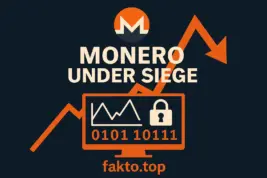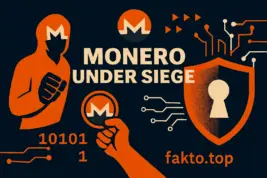Monero 51% Attack Privacy Crisis
Qubic Monero
Monero Under Siege: The 51% Attack That Shook the Privacy Coin World
In August 2025, the crypto world witnessed a seismic event: Monero, the flagship of privacy coins, faced a potential 51% attack. A mining pool known as Qubic reportedly gained control of more than half the network’s hash rate, triggering panic across exchanges, forums, and developer channels. For a coin built on decentralization and anonymity, this wasn’t just a technical threat — it was an existential one.

As exchanges froze deposits and traders scrambled for alternatives, the question loomed large: is this the beginning of the end for Monero, or just another battle in the war for financial privacy?
What Is a 51% Attack — and Why Is Monero Especially at Risk?
A 51% attack occurs when a single entity controls the majority of a blockchain’s mining power. This allows them to manipulate the ledger — reversing transactions, censoring blocks, and executing double-spends. For Monero, which relies on trustless privacy and decentralized consensus, such control undermines everything it stands for.
Monero uses RandomX, a CPU-optimized algorithm designed to resist ASIC centralization. But even RandomX can’t prevent mining pools from aggregating power. Qubic’s dominance exposed a flaw: while the algorithm is decentralized in theory, in practice, mining incentives still favor consolidation.
Here’s why Monero is uniquely vulnerable:
- Privacy by default: Every transaction is obfuscated, making auditing impossible.
- Smaller dev team: Less centralized governance means slower emergency response.
- Limited exchange support: Fewer onramps make liquidity fragile.
Exchange Reactions: Freeze, Flag, or Flee?
Major exchanges didn’t wait. Kraken immediately froze XMR deposits, citing “network instability.” Binance flagged Monero transactions for manual review. TradeOgre issued a warning but kept trading live. KuCoin remained fully operational but added disclaimers about potential delays.
This created a liquidity crunch. Traders couldn’t move XMR in or out easily. OTC desks reported a surge in demand for wrapped Monero (wXMR) on Ethereum, as users sought alternatives. Arbitrage dried up. Market depth thinned. And confidence wavered.
| Exchange | Action Taken | Status |
|---|---|---|
| Kraken | Deposits frozen | Trading active |
| Binance | Manual transaction review | Trading active |
| TradeOgre | Warning issued | Fully active |
| KuCoin | No restrictions | Fully active |
What Are the Risks for Monero Holders?
Let’s be blunt: Monero is in a trust crisis. The coin’s value proposition — untraceable, decentralized money — depends on network integrity. If users believe the chain can be manipulated, adoption stalls. Here are the key risks:
- Double-spending: Attackers could reverse transactions, undermining merchant trust.
- Price volatility: Fear-driven selloffs could tank XMR’s market cap.
- Exchange delistings: If instability persists, more platforms may drop support.
- ️ Regulatory pressure: Governments may use this as ammo to target privacy coins.
But it’s not all doom. Monero’s devs are already proposing emergency patches, including hash rate redistribution incentives and temporary block validation changes. The community is rallying — and that’s not something you see every day in crypto.

Developer Response: Emergency Patches, Forks, and the Road Ahead
Monero’s core devs didn’t waste time. Within hours of the 51% threshold being breached, discussions began around emergency countermeasures. Some proposals included:
- ⛏️ Hash rate redistribution: Incentivizing solo mining through temporary block rewards
- Checkpointing: Adding soft checkpoints to prevent chain reorgs
- Hard fork options: Splitting from compromised chain if necessary
These aren’t just technical fixes — they’re philosophical statements. Monero refuses to be centralized. And if that means forking, patching, or even rebuilding parts of the protocol, the devs are ready.
Community Resilience: More Than Just Code
While the panic around Qubic’s dominance grabbed headlines, the bigger lesson here is about resilience. Monero’s strength has never been just its code — it’s the global network of users, researchers, and developers who step up when pressure mounts. A 51% attack highlights technical fragility, but it also forces innovation and decentralization. If anything, this episode shows that Monero’s future depends less on avoiding threats altogether and more on how quickly and transparently the community adapts. For those following the project closely, the official Monero site (getmonero.org) remains the most reliable place to track real-time updates and long-term roadmaps.
Privacy Coins Compared: Who’s Next in Line?
Monero isn’t alone. Other privacy coins like Zcash, Dash, and Dero are watching closely. If Monero falls, they know they’re next. But each has a different approach to privacy — and different vulnerabilities.
| Coin | Privacy Type | Default Privacy | Auditability |
|---|---|---|---|
| Monero (XMR) | RingCT + Stealth + Bulletproofs | Yes | Very low |
| Zcash (ZEC) | zk-SNARKs | No | Medium |
| Dash (DASH) | Coin mixing | No | High |
| Dero (DERO) | Homomorphic encryption | Yes | Low |
Monero’s strength — privacy by default — is also its weakness. It’s harder to audit, harder to regulate, and harder to defend against centralization. But it’s also the most ideologically pure. That’s why it’s the first target — and the last line of defense.
Expert Opinions: What Are Crypto Veterans Saying?
We spoke with several anonymous crypto veterans, privacy advocates, and Monero OGs. Here’s what they had to say:
“This is a wake-up call. Monero needs to decentralize mining further — maybe even incentivize solo miners again.” — XMRCore contributor
“I’m not selling. I’m moving to cold storage and watching dev channels closely.” — OTC trader, NYC
“Privacy coins are under attack — not just technically, but ideologically. This won’t be the last attempt.” — Anonymous Zcash developer
Some whales are doubling down, buying the dip. Others are rotating into alternatives like Dero, Haven, or even Bitcoin with CoinJoin. The sentiment? Mixed, but resilient.
What Should You Do If You Hold Monero?
Here’s the pragmatic playbook for XMR holders:
| Action | Why It Matters |
|---|---|
| Move to cold storage | Protect your funds from exchange freezes or network instability |
| Monitor dev updates | Stay informed about patches, forks, and consensus changes |
| Avoid large transfers | Minimize risk of stuck or reversed transactions |
| Consider hedging | Diversify into other privacy coins or wrapped assets</ |
Long-Term Outlook: Will Monero Survive the Storm?
Let’s strip away the noise and look at the fundamentals. Monero isn’t just another altcoin — it’s the backbone of the privacy movement in crypto. It’s been delisted, demonized, and now destabilized. And yet, it’s still here. That resilience matters. It signals that Monero isn’t just surviving — it’s evolving.
Technically, the devs are already working on countermeasures. Philosophically, the community is doubling down. Economically, the dip is attracting long-term believers. This isn’t the first time Monero has faced existential threats. From chain analysis firms trying to crack its obfuscation, to regulators pressuring exchanges to drop it, Monero has always been under siege. But it’s never folded.

Here’s what gives Monero staying power:
- Protocol maturity: Years of development, testing, and refinement make it battle-hardened.
- ️ Ideological clarity: Monero doesn’t compromise on privacy — and that attracts loyal users.
- Global adoption: Used in real-world commerce, remittances, and peer-to-peer markets.
- Developer agility: Small but focused team capable of rapid iteration and forks.
Of course, risks remain. If mining centralization isn’t addressed, future attacks could be more damaging. If exchanges continue to restrict access, liquidity could dry up. And if regulators escalate their war on privacy, Monero may face legal headwinds. But none of these are fatal — unless the community gives up. And right now, that’s not happening.
In fact, this attack may be the catalyst for Monero’s next evolution. More decentralized mining pools. Stronger incentives for solo miners. Smarter consensus rules. And maybe even a cultural shift toward hybrid privacy models that balance anonymity with resilience. The future isn’t guaranteed — but it’s still in Monero’s hands.
Final Takeaways: What This Means for You, and for Crypto
If you hold Monero, this is your moment to act — not react. Panic selling helps no one. Strategic thinking does. Move your coins to cold storage. Follow dev updates. Support decentralization efforts. And most importantly, understand what Monero represents: a refusal to be surveilled, tracked, or controlled.
For traders, this is a volatility play. Expect wild swings. Use tight stop-losses. Watch exchange announcements like a hawk. Arbitrage opportunities may emerge between wrapped Monero and native XMR. But don’t get caught holding illiquid bags if another freeze hits.
For builders, this is a wake-up call. Privacy infrastructure needs redundancy. Wallets should support multiple chains. Mining software should be open-source and community-audited. And protocols should be designed with attack scenarios in mind. Monero’s pain today could be your blueprint tomorrow.
And for the broader crypto community? This is a philosophical fork in the road. Do we want a future where every transaction is tracked, every wallet is KYC’d, and every user is profiled? Or do we fight for a parallel system — one that values freedom, anonymity, and resistance?
Monero isn’t perfect. But it’s principled. And in a space increasingly driven by hype, regulation, and centralization, that matters more than ever.
So here’s the bottom line: Monero is under siege, but not defeated. The attack exposed weaknesses — and sparked innovation. The community is rallying. The devs are building. And the coin still stands. If you believe in privacy, now’s the time to support it. Not just with words, but with code, capital, and conviction.
Because in the end, privacy isn’t a feature. It’s a fight. And Monero is still on the front lines.
P.S
The Monero network just got hit with a wake-up call that shook the entire privacy coin ecosystem. A mining pool, Qubic, allegedly crossed the 51% hash rate threshold — a move that sent shockwaves through exchanges, traders, and hardcore cypherpunks. This isn’t just a technical anomaly; it’s a full-blown existential threat. A 51% attack means potential double-spends, chain reorgs, and censorship — the kind of stuff that turns trustless systems into ticking time bombs. Kraken froze XMR deposits, devs scrambled to patch vulnerabilities, and the community rallied like a digital militia. Monero, the gold standard of anonymous crypto, now finds itself in a battle not just for stability, but for survival. The irony? A coin built to resist surveillance is now under siege from within. But here’s the twist — this might be the moment Monero evolves. More decentralization. Smarter mining incentives. Stronger consensus rules. If it survives this, it won’t just be resilient — it’ll be legendary. Privacy isn’t dead. It’s just under attack. And Monero? It’s still fighting.
Disclaimer / No Liability
We are not financial advisors and assume no responsibility for any decisions you make.
Cryptocurrencies are highly volatile and risky. You may lose all invested capital.
Always do your own research (DYOR) and consult qualified professionals before making any financial or legal decisions.
We make no guarantees regarding the accuracy, completeness, or reliability of the information provided.
References to third-party services or projects do not imply endorsement.
By using this site, you agree that all actions are at your own risk and you release the site owners and authors from any liability.
